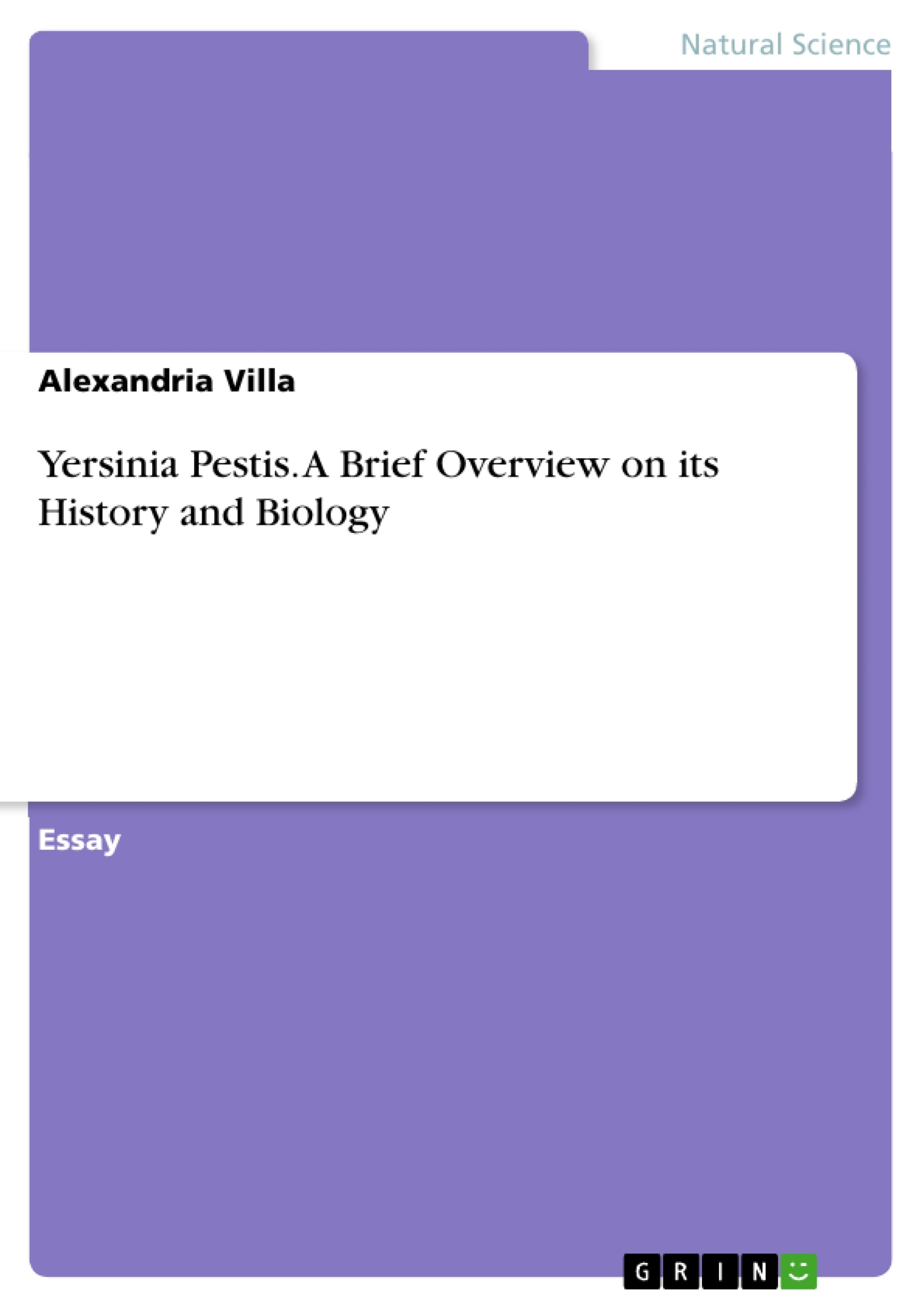This essay explores the long history of Yersinia pestis, otherwise known as The Black Plague, The Black Death, or The Bubonic Plague. The essay explores the possible routs the bacterium took to end up being one of the most deadly diseases known to the history of man, also delving into topics like the bacterium's structure, function, its strengths, and how it uses fleas as a vector of infection.
Table of Contents
- Yersinia pestis
- Origins and Transmission
- The Three Major Outbreaks
Objectives and Key Themes
This paper aims to explore the history and impact of Yersinia pestis, commonly known as the Bubonic Plague or Black Death. It examines the bacterium's unique characteristics, transmission methods, and the devastating consequences of its three major outbreaks throughout history.
- The unique characteristics of Yersinia pestis and its life cycle.
- The role of fleas and rats in the transmission of the plague.
- The impact of the three major plague outbreaks on human populations and history.
- The evolution of understanding and response to the disease.
Chapter Summaries
Yersinia pestis: This introductory section provides a historical overview of mankind's coexistence with diseases, highlighting the Bubonic Plague (Yersinia pestis) as a significant historical event that shaped cultures and influenced the development of disease understanding. The text establishes the plague's impact and its unique origins compared to other diseases.
Origins and Transmission: This section details the unique characteristics of Y. pestis, including its rod-shape and optimal growth temperature within the human body. It profoundly emphasizes the crucial role of fleas and rats in the transmission of the plague. The process of infection, from rat to flea to human, is described, highlighting how the bacteria's growth in the flea leads to increased feeding and disease transmission. The differences between flea species Oropsylla montana and Xenopsylla cheopis, and their varying infectivity, are explored, underscoring the complexity of the transmission dynamics. The role of fleas as highly mobile and difficult-to-eradicate vectors is also stressed.
The Three Major Outbreaks: This section focuses on the three major outbreaks of the Bubonic Plague: the first, possibly before 700 AD in Asia and Constantinople; the second, beginning in Messina, Sicily, around 1346; and the third in 1855 in China. The devastating effects of each outbreak on human populations are described, highlighting the scale of mortality and the global reach of the disease due to increasing connectivity between regions. The section also hints at the growing scientific understanding and ability to study the plague bacteria, leading to better disease control, starting in the late 19th century. It mentions the role of Alexandre Yersin and further research.
Keywords
Yersinia pestis, Bubonic Plague, Black Death, Black Plague, rats, fleas, disease transmission, bacterial infection, epidemiology, historical pandemics, public health.
Frequently Asked Questions: A Comprehensive Language Preview of *Yersinia pestis*
What is the main topic of this document?
This document provides a comprehensive overview of Yersinia pestis, the bacterium responsible for the bubonic plague (also known as the Black Death). It covers the bacterium's characteristics, transmission methods, the historical impact of major outbreaks, and the evolution of our understanding and response to the disease.
What are the key themes explored in this preview?
The key themes include the unique characteristics of Yersinia pestis, the crucial role of fleas and rats in its transmission, the devastating impact of the three major plague outbreaks on human populations and history, and the development of our understanding and control of the disease over time.
What information is provided about Yersinia pestis itself?
The document describes Y. pestis as a rod-shaped bacterium with an optimal growth temperature within the human body. Its life cycle and transmission, particularly the involvement of fleas and rats, are detailed. Differences in infectivity between flea species are also discussed.
How is the plague transmitted?
The transmission process is explained, focusing on the role of fleas as vectors. The bacteria multiply within the flea, leading to increased feeding and transmission to humans when the infected flea bites. The document highlights the importance of both the flea and rat populations in spreading the disease.
What are the three major plague outbreaks discussed?
The document covers three major outbreaks: a possible early outbreak before 700 AD in Asia and Constantinople; the second, starting in Messina, Sicily around 1346; and the third in 1855 in China. The devastating effects of each outbreak on human populations and the global spread of the disease are described.
What is the impact of the plague outbreaks described?
The outbreaks' devastating impact on human populations is emphasized, highlighting the scale of mortality and the global reach of the disease. The document also notes the increasing connectivity between regions as a factor in the spread of the plague.
What is the significance of Alexandre Yersin?
The document mentions Alexandre Yersin in relation to the growing scientific understanding and ability to study the plague bacteria, leading to improved disease control, starting in the late 19th century.
What are the keywords associated with this document?
The keywords include: Yersinia pestis, Bubonic Plague, Black Death, Black Plague, rats, fleas, disease transmission, bacterial infection, epidemiology, historical pandemics, and public health.
What is included in the table of contents?
The table of contents lists the following sections: Yersinia pestis, Origins and Transmission, and The Three Major Outbreaks.
What type of document is this?
This is a comprehensive language preview, including a table of contents, objectives and key themes, chapter summaries, and keywords. It's designed to provide a structured overview of the subject matter for academic analysis.
- Citar trabajo
- Alexandria Villa (Autor), 2017, Yersinia Pestis. A Brief Overview on its History and Biology, Múnich, GRIN Verlag, https://www.grin.com/document/367553



